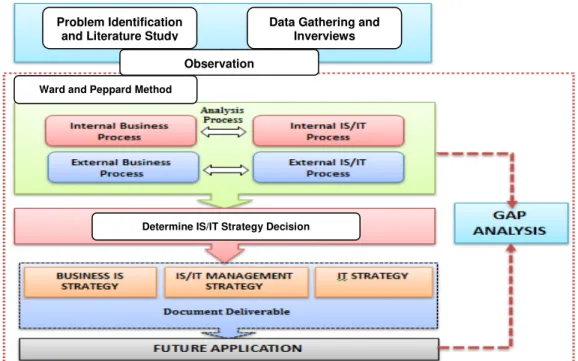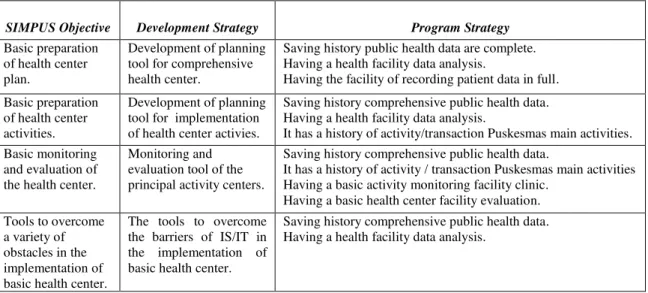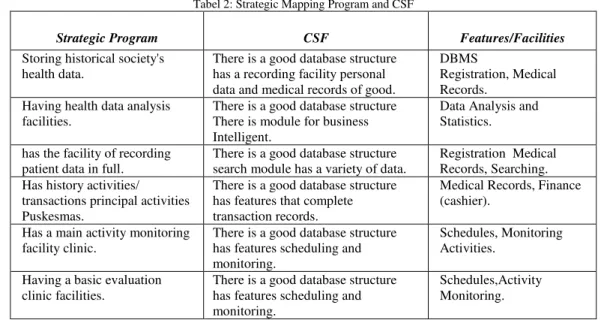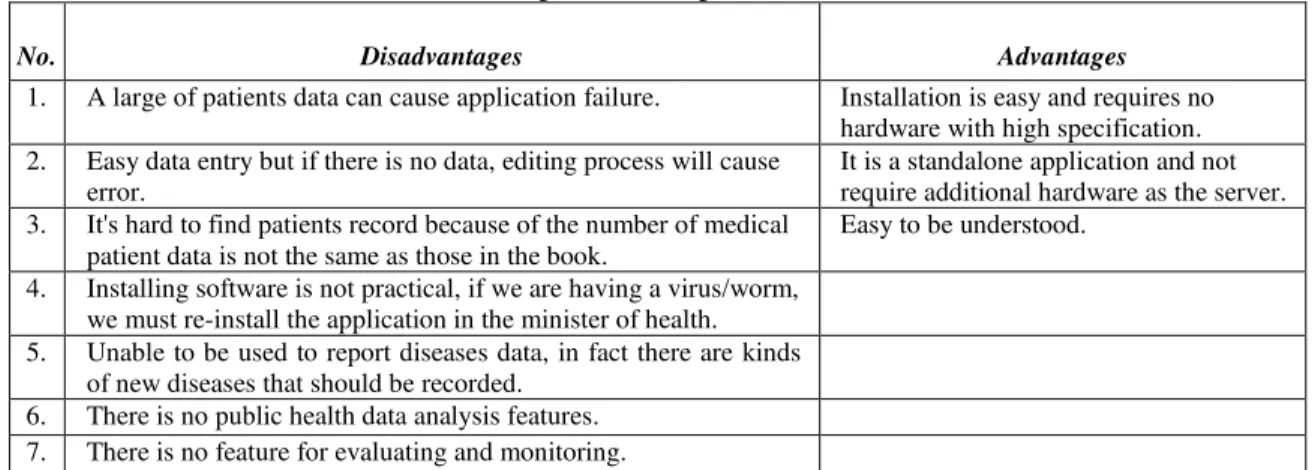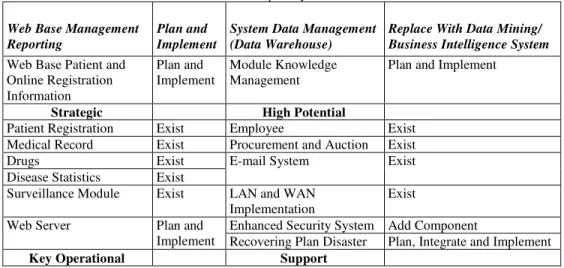Assessment of Information Technology and Data Communication
and Management within Community Health Services in Jakarta
Aan Kardiana1, Sri Puji Utami A2, Hendriawan Widiatmoko3, Dana Indra Sensuse4, Heru Suhartanto5
1,2,3
Faculty of Information Technology, YARSI University Jakarta, 10510, Indonesia
4,5
Faculty of Computer Science, University of Indonesia Depok, 16424, Indonesia
Abstract
Puskesmas is a public health center, that is the most basic health care and cutting edge services in Indonesia. Public health development in Indonesia needs to get more serious attention, especially on the quality of services through Puskesmas. This study assess the ICT empowerment and provides recommendation for the future of Health Center Management Information System (SIMPUS) using Ward and Peppard method. This method requires four analysis to determine the condition of the organization and conditions of Information Systems/ Information Technology (IS/IT), those are the External Business Analysis, Internal Business Analysis, External IS/IT Analysis and Internal IS/IT Analysis. The results show that the health centers should to develop new modules according to the urgency of the needs of existing businesses. Applications that need to be prioritized are: patient record systems and medical records. The success of the IS/IT implementation in Puskesmas needs the support for monitoring and good control IS/IT strategic plan. Keywords: Puskesmas, Health Centers, SIMPUS, Ward and Peppard, Information Systems.
1.
Introduction
Puskesmas (Community Health Centers), is a functional organization to organizes health services that is comprehensive, integrated, equitable, acceptable and affordable to the public. Puskesmas activities are funded by the government and society. Puskesmas should emphasize its public health services in order to achieve optimal health standard. Azwar (1996) suggested, Puskesmas as the place to implement a functional unit that serves as the development of health, fitness enhancement of community participation in health and the first layer of health care activity.
Since Puskesmas as the most basic health care, cutting edge services and public health development in Indonesia then Puskesmas needs to get more serious attention, especially on the quality of service that should be in accordance with the nature of healthcare reform in Indonesia.
The Minister of Health has developed a National Health Information System (SIKNAS) starting with integrated recording and reporting in the early 1970's. The development of SIKNAS conducted in 1984 with the establishment of health data center. However, this development still faces some obstacles for example there are less accurate, less as needed, and less rapid data and information presented (Minister of Health, 2007).
Health information system is an information management at all levels of government organizations systematically determined in respect of the services to the people governed by the Decree of the Minister of Health (Kepmenkes) No. 004/Menkes/SK/I/2003 of Policy and Strategy for the Health Sector Decentralization and Kepmenkes No. 932/Menkes/SK/VIII/2002 on the Implementation of Health Information Reporting System Development (Minister of Health, 2003).
SIMPUS version 1.00 is a Health Information System Integration at Village level. SIMPUS plays role as the information processing system to present information to management and decision-making at both the sub-district health centers and district level. This SIMPUS still can be a solution for the data centers management, especially in terms of speed of information presented and as a communicator between the clinic and the Minister of Health. One of the basic problems of SIMPUS is that this system still based on desktop application or standalone and do not uses adequate communication technologies. This encourages us to have a study to look at the current SIMPUS deployment. The result of this research is expected to be the basic for replanning and re development of the SIMPUS according to the current needs and future challenges.
2.
Methods and Results
This research is conducted in Jakarta and supported by some Puskesmas in the city.
This study uses information systems planning Ward & Peppard (Figure 1). In the beginning of research we are collecting data and supporting documents using observations or interviews and then, we do the analysis of the influencing factors.
2.1
Problem Formulation and Literature
This stage is divided into a few stages: formulating of the problem; literature studying; collecting data, and interviews. The collection of materials is obtained by searching for academic papers and publications using the internet and libraries. We also collect legal document that is legally binding decrees, regulations (the local level to the central level) as the main reference system planning. Legal documents that we can obtain are objective of Puskesmas, Puskesmas strategic planning, IS/IT services, and public health services Standard Operating Procedure (SOP). This SOP were collected from 79 Puskesmas in Jakarta, which consists of 64 urban non-maintenance level health centers, 2 non-care district level health centers, 4 urban care level health centers, and 9 district level health center.
The results of this phase are: collected literature on strategic planning, IS/IT and SIMPUS; questionnaires and interviews with: Chief Medical Officer of DKI Jakarta, business ICT in Public Health, Head of ICT in the health centers and health center business as well as a sample list of research centers. Data collection and interviews were conducted after we have a permission from Governor's Decree.
Fig. 1 IS/IT Strategic Planning based on Ward and Peppard Method
Problem Identification and Literature Study
Data Gathering and Inverviews
Ward and Peppard Method
Determine IS/IT Strategy Decision
3.
Analysis Process
Analysis process consists of External Business Process, External IS/IT Process, Internal Business Process and Internal IS/IT Process. The external environmental analysis center using PEST (Politic, Economy, Social, and Technology) method and SWOT (OT) opportunity is focused on threat (OT).
PEST method results are:
1. Politics: There are already SIMPUS rules and technical guidelines to present a report to the Minister of Health. Those documents are:
a. The decree of the Minister of Health No. 128/MENKES/SK/II/2004 on basic policies of Puskesmas.
b. The decision of the Chief Medical Officer of DKI No. 7719/2004. Technical Guidance on Implementation of SIK Integration in DKI Jakarta Provincial Health Office, and the Public Health Agency Municipal health services and district health centers and Village.
c. Instructions of Chief Medical Officer of DKI Jakarta No. 10/2004 concerning about Integrated Development of SIK in Provincial Health Office Jakarta.
2. Economy: The average standard of living and community knowledge Strata One health center which is the target users is still low. This encourages people to use as a health care clinic. Therefore SIMPUS should be simple, easy to use, attractive and accessible by various devices so that people actively using SIMPUS as a means of health information system.
3. Social: Need to change the culture of health and encourage administrative personnel, the public and stakeholders to use SIMPUS. Therefore SIMPUS need to provide informative features and simple user interface to anticipate the cultural diversity of Indonesia
4. Technology: Modern technology should be implemented although it requires huge cost of ICT investments. SIMPUS expected based on web and mobile web, so that people easily access and use it.
The results of the analysis of the external environment IS/ IT are:
1. Trends in Computer Networking
The development of computer network technology, especially the internet offers a variety of facilities and services in terms of efficient communication and collaboration; business transaction activity and supply access to information. It also changes the cultures and the ways of working people throughout the world.
2. Database Trends and Applications
The technology development of information systems and database applications from stand alone, evolved into a client-server and Web (n-tier). In addition, the exchange of data between applications is also made easier with the advent of SOA (Service Oriented Architecture), Web Services, and XML. Similarly, the formerly centralized database is lead to a distributed database synchronizer with the help of the entire database application to integrate physically spread across several different machines. 3. Trends in Open Source Applications
The computer world is growing with a new approach in software development. Software patent has been recognized and implemented in the United States, while in Indonesia the protection of IPR (Intellectual Property Rights) still encounter problems because of the high rate of piracy of software product. Another approach is the Free Software Foundation, which support the GNU Public License (for software or tools known as GNU), as well as other groups who pioneered copyleft, copywrong, public domain, and the like. Currently, one popular approach is the open source approach, in which the source code of an application or software package may be obtained or viewed by the public, even though the source code is not necessarily public domain. The example of well-known open source software such as the Linux (operating system), Apache (web server), PERL, Java, PHP (application tools), MySQL (database server) and many others.
In Internal Business Process, the process get input from interviews with stakeholders and look at the current trends in ICT development as material analysis and comparison between the internal condition of IS/IT centers and ICT current trends. Internal and External Business Process is expected to generate input and consideration to produce IS/IT solutions that fit the needs based on current trends. In the Internal IS/IT Process, internal environment of IS/IT were analyzed to see information systems and technology available today. The result is a current application portfolio, used as a comparison between the present and the future development plans. The input for this analysis is the direct surveys and interviews with the management of information systems. Furthermore, the data was analyzed by mapping the needs of IS/IT into the strategic grid (Ward and Peppard, 2003).
Menkes No: 128/MENKES/SK/II/2004. The outline contains:
1. The main business activity of the Community Health Center is to serve the community at the first level (individual and community) in the health sector.
2. Vision and Mission
Vision: "The achievement towards the creation of District Health Healthy Indonesia"
Mission:
a. Moving health oriented development. b. Encourage independence healthy living for
families and communities.
c. Maintaining and improving the quality, equity and affordability of healthcare. d. Maintaining and improving the health of
individuals, families and communities and their environments.
3. Objective
To achieve the vision and mission of the health center, the objectives to be achieved are: "Raising awareness, willingness and ability of healthy life for every person who resides in the working area health centers in order to realize the health status of the highest in order to achieve Healthy Indonesia 2010"
4. Community Health Center Main Activities a. Mandatory Health Efforts
1) Health Promotion Efforts 2) Environmental Health Efforts
3) Efforts Maternal and Child Health and Family Planning
4) Community Nutrition Improvement Efforts
5) Prevention and Eradication of Infectious Diseases
6) Treatment Efforts b. Health Development Efforts
1) The School Health 2) Sports Health Efforts
3) Community Health Care Efforts 4) Occupational Health Efforts 5) Efforts Dental and Oral Health 6) Mental Health Efforts
7) Eye Health Efforts 8) Elderly Health Efforts
9) Traditional Medicine Development Efforts
5. The Objective of SIMPUS divided into two, those are:
a. General purpose SIMPUS implementation is improving the quality of health center management to be more effective and efficient through optimum utilization of Data Recording and Reporting System Integrated Health Centers (SP2TP) and other supporting information.
b. Special purpose SIMPUS implementation is in the preparation of basic health center level planning, execution planning basic principal activity centers, basic monitoring and evaluation of basic health centers, as well as to overcome various obstacles in the implementation of basic health centers.
Based on the vision, mission, goals, health center efforts, and the purpose of the SIMPUS, then we can specified program strategies and features of SIMPUS. Table 1 shows the strategy and program development features of SIMPUS. Table 2 shows the mapping of Strategic Programs and Critical Success Factor (CSF) Analysis.
Tabel 1: SIMPUS Objectives and Strategic Mapping
SIMPUS Objective Development Strategy Program Strategy
Basic preparation of health center plan.
Development of planning tool for comprehensive health center.
Saving history public health data are complete. Having a health facility data analysis.
Having the facility of recording patient data in full.
Basic preparation of health center activities.
Development of planning tool for implementation of health center activies.
Saving history comprehensive public health data. Having a health facility data analysis.
It has a history of activity/transaction Puskesmas main activities. Basic monitoring
and evaluation of the health center.
Monitoring and evaluation tool of the principal activity centers.
Saving history comprehensive public health data.
It has a history of activity / transaction Puskesmas main activities Having a basic activity monitoring facility clinic.
Having a basic health center facility evaluation.
Tools to overcome a variety of obstacles in the implementation of basic health center.
The tools to overcome the barriers of IS/IT in the implementation of basic health center.
Tabel 2: Strategic Mapping Program and CSF
Strategic Program CSF Features/Facilities
Storing historical society's health data.
There is a good database structure has a recording facility personal data and medical records of good.
DBMS
Registration, Medical Records.
Having health data analysis facilities.
There is a good database structure There is module for business Intelligent.
Data Analysis and Statistics.
has the facility of recording patient data in full.
There is a good database structure search module has a variety of data.
Registration Medical Records, Searching. Has history activities/
transactions principal activities Puskesmas.
There is a good database structure has features that complete transaction records.
Medical Records, Finance (cashier).
Has a main activity monitoring facility clinic.
There is a good database structure has features scheduling and monitoring.
Schedules, Monitoring Activities.
Having a basic evaluation clinic facilities.
There is a good database structure has features scheduling and monitoring.
Schedules,Activity Monitoring.
The SWOT Analysis results are: 1. Strength
a. There are a lot of health center which is able to serve the public, thus SIMPUS should have a large patient data.
b. Health center is located almost in each district and village, serving the people of the upper middle strata.
c. SIMPUS has the technical implementation guidance .
d. There are standards for recording and reporting through SP2TP to SIMPUS.
e. There are rules about the minimum service to the public health field. There are standard features of the SIMPUS.
2. Weakness
a. SIMPUS application has not been online yet, system reporting from the village to the district are done manually.
b. Substantial number of patients often causes errors during recording and processing of data..
c. Policies change in the rules of data management make the report (format) change every year.
d. Recording and processing of data on a large scale requires adequate hardware support. e. Lack of human resources expertise in ICT. 3. Opportunities
a. The widespread use of ICT encourages the development of SIMPUS, and it makes the level of knowledge in the field of ICT increases.
b. The development of communication technology pushed the development of Web-based SIMPUS.
c. Awareness and support of health center chief encourages advancement and enhanced features of SIMPUS.
d. The important analysis encourages the need for feature analysis and evaluation of data. 4. Threat
a. Large ICT investments can be an obstacle in implementation of online-based SIMPUS. b. Lack of sharing experience in utilizing
SIMPUS between centers.
c. The number of different types of health center information system similar with SIMPUS will encourage the use of different information system.
From the interviews, questionnaires and analysis of the internal condition of IS/IT we have the following findings are :
1. Overview of condition data processing centers in the form of user needs are:
a. Users need a user friendly data entry features b. Consistent format data
c. System integrated with SIKNAS
d. Complete medical data record, and the search feature by various criteria.
e. The data analysis facilities for the patient's medical health history.
2. While the disadvantages and advantages of the current SIMPUS can be seen in Table 3.
Table 3: Disadvantages and Advantages of The Current SIMPUS
No. Disadvantages Advantages
1. A large of patients data can cause application failure. Installation is easy and requires no hardware with high specification. 2. Easy data entry but if there is no data, editing process will cause
error.
It is a standalone application and not require additional hardware as the server. 3. It's hard to find patients record because of the number of medical
patient data is not the same as those in the book.
Easy to be understood.
4. Installing software is not practical, if we are having a virus/worm, we must re-install the application in the minister of health. 5. Unable to be used to report diseases data, in fact there are kinds
of new diseases that should be recorded. 6. There is no public health data analysis features. 7. There is no feature for evaluating and monitoring.
3. Priorities development and improvement for the next SIMPUS can be seen in Table 4 :
Table 4: Priority Development and Improvement for The Next SIMPUS
No. Name Description
1. Changing application platform.
Change application platform from desktop-based into Web-based applications with the same features. 2. Integrate. Integrating applications until sub-district level. 3. Repair database. Without changing feature, perform reengineering
database structure to support the simple recording . 4. Improved logging
feature.
Patient data recording feature and medical records corrected by changes in the database structure. 5. Repair report. Repair reporting feature, in order to get report easier. 6. Analysis feature. Adding analysis feature of health data, such as
epidemics or outbreaks of certain diseases. 7. Monitoring and
Evaluation Feature.
Adding features monitoring and evaluation of each principal activity centers.
4.
Determination IS/IT Strategy
The results of the analysis of internal and external environment in the previous stage becomes the input for this stage and yield management policy proposals Data centers in the form of business IS strategy, IS/IT managements strategy, IT strategy and Standard Operating Procedures (SOP) of SIMPUS.
Development plans based on SWOT analysis and critical success factors are needed in SIMPUS, these are:
1. Strength Opportunity Strategy
a. Improve the structure of the database and changes in Database Management System.
b. Change application to a web based application that can be online and integrated.
c. Develop a reporting facility.
2. Strength Threat Strategy
a. Reinforce socializing and communication with the public.
b. Application with rich-feature and compatible across platforms.
c. Use Open Source Technologies for optimum investment.
3. Weakness Opportunity Strategy
a. Develop a web-based application or use internet advice.
b. Use new technologies appropriately to improve the quality to maintain heath care for patients. c. Provide telemedicine facilities.
4. Weakness Threat Strategy
a. Optimize the use of infrastructure to improve service.
5.
Future Application and Gap Analysis
SOP is used as an input for the SIMPUS analysis and planning. At this stage, gap analysis is against the current application portfolio and future application portfolio. The results were then analyzed to create a problem formulation
and planning of information systems to be constructed. Gap analysis was conducted on the existing applications and new applications development to determine what action needs to be done for each application. This is shown in the matrix in Table 5 below:
Table 5: Gap Analysis Matrix
Web Base Management Reporting
Plan and Implement
System Data Management (Data Warehouse)
Replace WithDataMining/ Business Intelligence System
Web Base Patient and Online Registration Information
Plan and Implement
Module Knowledge Management
Plan and Implement
Strategic High Potential
Patient Registration Exist Employee Exist Medical Record Exist Procurement and Auction Exist
Drugs Exist E-mail System Exist
Disease Statistics Exist
Surveillance Module Exist LAN and WAN Implementation
Exist
Web Server Plan and Implement
Enhanced Security System Add Component
Recovering Plan Disaster Plan, Integrate and Implement
Key Operational Support
Based on the gap analysis above, there are eight kinds of assessments that can be given to provide an overview of changes to the information system applications, these are - Optimize
This assessment means that the applications existed but have not used optimally, it is necessary to improve the application performance, so that the application can contribute more to the business of Puskesmas.
- Plan & Implement
This assessment means that the application does not exist, so we need the planning and implementation of the application.
- Plan, Implement & Integrate
This assessment explains that some components of the existing applications. It is necessary to plan the system structure, implementation of the application components and then integrates all the necessary components into integrated information systems. For example, the Disaster Recovering Plan System.
- Implement
Assessment describes the details of the planning application that existed before , but not yet implemented. It is necessary for the implementation of the application. - Exist
This assessment explains that the application already exists and is ready for use.
- Add Component
Assessment explains that the application already exists, but needs the addition of components (media) so that the application can be used optimally.
- Merge with ... (existing application-specific)
This assessment explains that existing applications will be integrated into other existing applications, so that a single unit that can function optimally.
- Replace with ... (existing application-specific)
This rating explains that the existing application functions will be replaced by other applications, although it is possible that the new app is actually an evolution of older applications that replaced it. For example: Replacement system data warehousing of existing with a system of data mining/business intelligence.
6.
Conclusions
From this study we conclude that :
1. Health centers need to innovate continuously, in order to improve public health service to the community. 2. Making IS/IT strategic plans is a vital strategy in
bringing innovations in the field of ICT. This is a major contribution to achieve the vision.
3. Recruit IT Managers whose tasks include conducting research, planning, implementation and maintenance of IS/IT.
public services and systems business intelligence to identify needs and see the statistics .
5. Monitoring and good control IS/IT strategic plan support will determine the success of the IS/IT implementation.
Acknowledgments
This study is one of research roadmap of the Faculty of Information Technology, YARSI University, and funded by the Directorate General of Higher DIPA Education Ministry of National Education through Hibah Pekerti Grant
References
[1] ______, Kebijakan dan Strategi Pengembangan Sistem Informasi Kesehatan Nasional (SIKNAS), Departemen Kesehatan Republik Indonesia, Jakarta, 2007.
[2] ______, Keputusan Kepala Dinas Kesehatan Propinsi DKI No. 7719/2004 tentang Juknis Pelaksanaan SIK Integrasi di Dinkes Propinsi DKI Jakarta, Sudin Kesmas dan Yankes Kotamadya dan Puskesmas Kecamatan dan Kelurahan, 2004.
[3] ______ , Keputusan Kepala Dinas Kesehatan Propinsi DKI Jakarta No.6661/2004 tentang Kebijakan Perencanaan Dinas Kesehatan Propinsi DKI Jakarta Tahun 2005, 2004.
[4] ______, Instruksi Kepala Dinas Kesehatan Propinsi DKI Jakarta Nomor 10/2004 tentang Pengembangan SIK yang Terpadu dan Terintegrasi di Lingkungan Dinas Kesehatan Propinsi DKI Jakarta, 2004.
[5] AbouZahrl, C., dan Boermal, T., Health Information System, The Foundation of Public Health in Bulletin of the World Health Organization August, 2005.
[6] Azwar, A., Dasar-dasar Perencanaan di Bidang Kesehatan, Badan Ilmu Kesehatan Masyarakat dan Ilmu Kedokteran Pencegahan-FKUI, Jakarta, 1996.
[7] Departemen Kesehatan R.I., Sistem Kesehatan Nasional, Departemen Kesehatan Republik Indonesia, Jakarta, 2003. [8] Gondoputro, S., Rekam Medis dan Sistem Informasi
Kesehatan di Pelayanan Kesehatan Primer (Puskesmas), Bagian Ilmu Kesehatan Masyarakat Fakultas Kedokteran Universitas Padjajaran, Bandung, 2007.
[9] Iswara Made Gde Yoga, Sucahyo Yudho Giri, “Perencanaan Strategis Sistem Informasi Perusahaan Energi : Studi Kasus PT. XYZ”, Jurnal Konferensi Nasional Sistem dan Informatika 09-049, 2009.
[10] McLeod, Jr, Raymond, Sistem Informasi Manajemen Jilid I, Edisi Bahasa Indonesia, Penerjemah : Hendra Teguh, Editor Hardi Sukardi, PT Buana Ilmu Populer, Jakarta, 1996. [11] Sunarto, Agus, Hasibuan, Zainal A., “Model Perencanaan
Strategis Sistem Informasi Pada Industri Penyiaran Televisi Dengan Pendekatan Blue Ocean Strategy Dan Balance Scorecard”, Jurnal Sistem Informasi MTI UI 3:2, 2007. [12] Ward, J, Peppard, J., Strategic Planning For Information
System, Third Edition, John Willey & Sons, LTD, England, 2003.
[13] Wiseman, C. and MacMillan, I., Creating weapons from information systems, Journal of Business strategy 5:2, 1984, 42-49.
Aan Kardiana holds BSc from Bandung Institute of Technology and MSc from IPB (Bogor, Indonesia) in 2000. He is currently an academic, research staff and Head of Computational Intelligent Research Group of Faculty of Information Technology, YARSI University. His research interests are data mining, statistics and e-Health. He is also a member of YARSI E-Health Research Center (YEHRC); has won some research grants; published a number of national papers in proceeding.
Sri Puji Utami Atmoko holds B.Eng and M.Eng from Faculty of Electrical University of Indonesia in 2002. She is currently an academic, research staff and Head of Computer Network and Communication of Faculty of Information Technology, YARSI University. Her research interests are networking and e-Health.
Hendriawan Widiatmoko holds Bachelor of Computer Science and Master of Computer Science from Faculty of Computer Science University of Indonesia in 2008. He is currently an academic and research staff of Faculty of Information Technology, YARSI University. His research interests are information system and e-Health.
Dana Indra Sensuse holds B.Sc in Soil Science (Bogor Agricultural Institute, Indonesia, 1985), Master in Library and Information Studies (Dalhousie University, Halifax, Canada, 1994), Ph.D. in Information Studies (Toronto University, Canada, 2004), Lecturer at University of Indonesia, Head of e-Government Laboratory at University of Indonesia.
